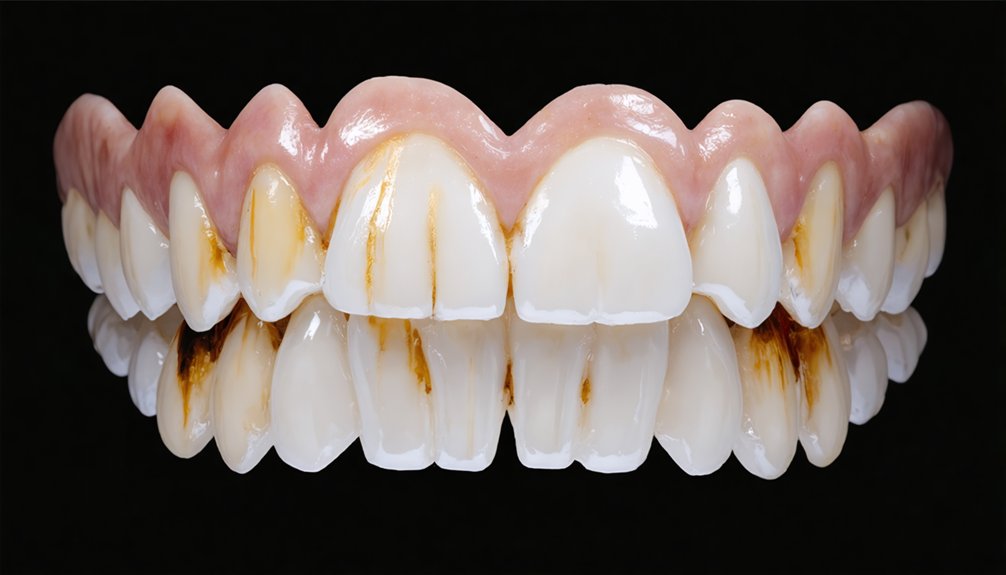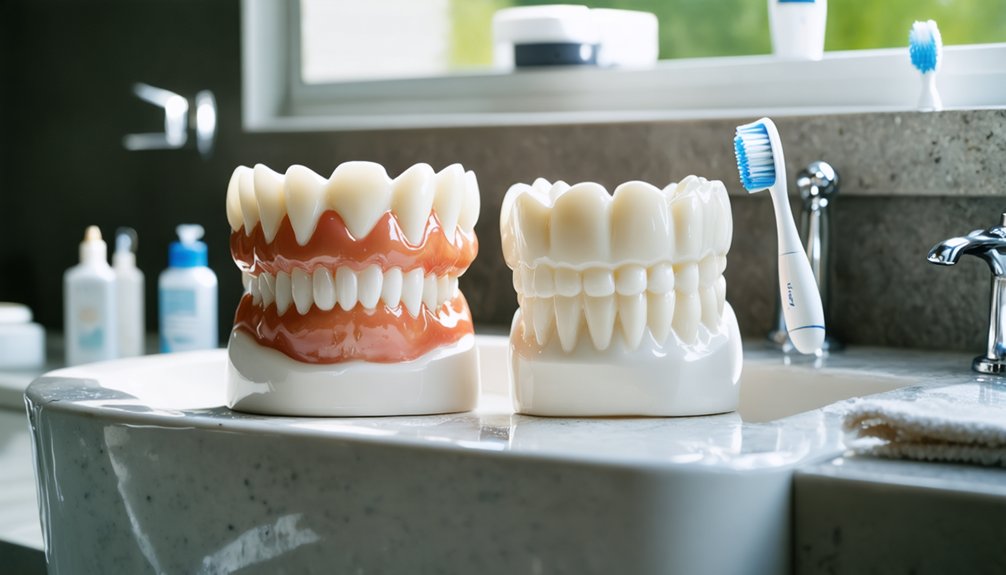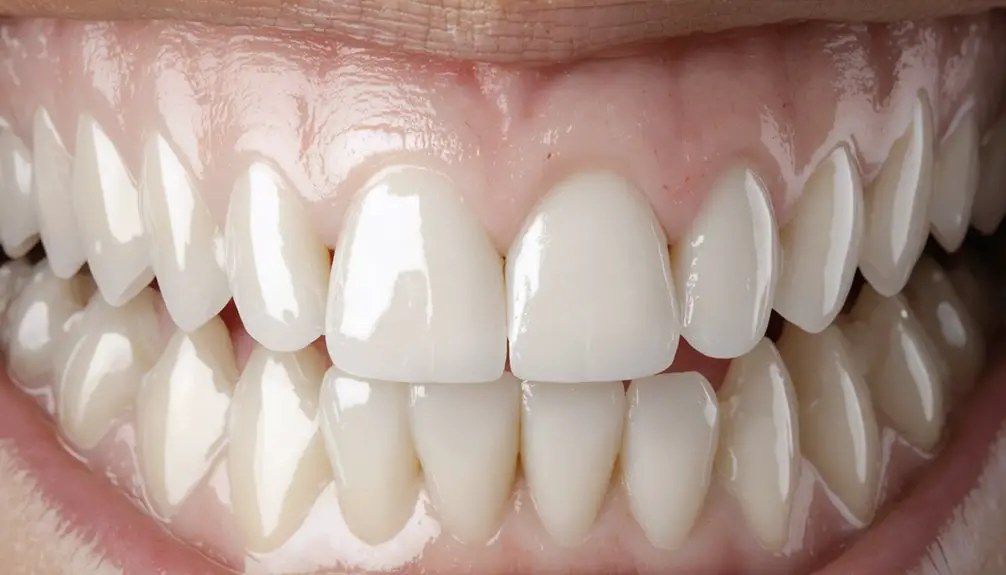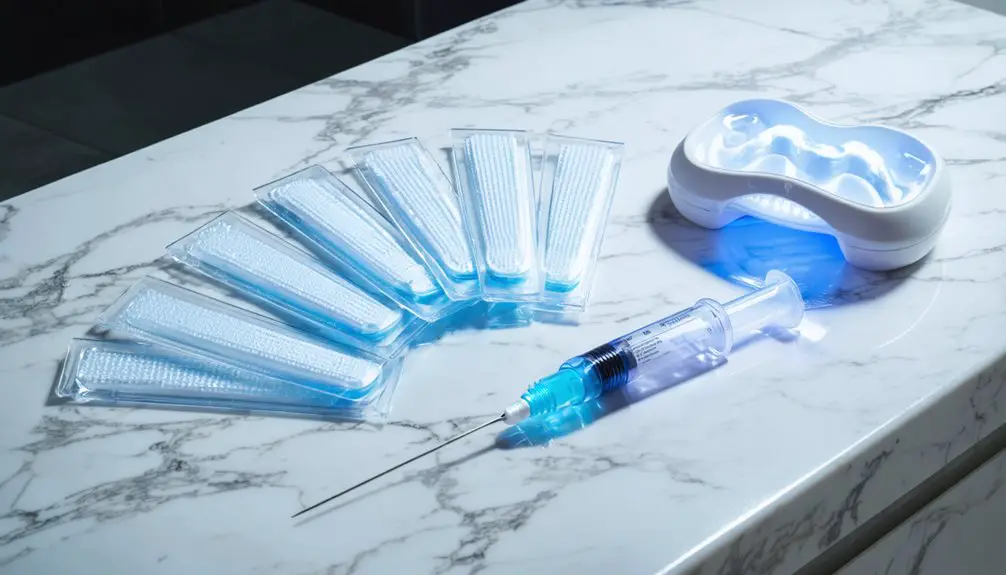You’ll need a combination of professional and at-home treatments to effectively combat tobacco stains on your teeth. Professional whitening treatments using high-concentration bleaching agents can tackle deep-set discoloration in just one hour, while custom-fitted trays with carbamide peroxide offer gradual improvement at home. Managing sensitivity is vital during treatment, so consider desensitizing gels and avoid hot or cold foods. The key to lasting results lies in understanding tobacco’s impact and implementing proper maintenance strategies.
Key Takeaways
- Professional laser whitening treatments combined with bleaching gels provide the fastest and most effective results for tobacco-stained teeth.
- Custom-fitted bleaching trays used with 10% carbamide peroxide offer significant improvement when used consistently at home.
- Schedule more frequent dental cleanings to remove surface stains and prevent deep-set tobacco discoloration.
- Use straws when drinking staining beverages and maintain thorough oral hygiene to minimize additional discoloration.
- Consider multiple deep bleaching sessions for stubborn tobacco stains, as single treatments may not suffice.
Understanding Tobacco’s Impact on Tooth Discoloration
While smoking is widely known for its health risks, its effects on dental aesthetics are particularly visible through tooth discoloration.
When you smoke, tobacco effects begin immediately as tar and nicotine interact with your teeth. These components don’t just sit on the surface – they actively penetrate your enamel, creating both surface and deep stains that worsen over time.
Your tooth enamel’s porous nature allows nicotine, which turns yellow-brown when oxidized, to seep deep into its structure. The heat from smoking accelerates this process, while tar creates a sticky film that attracts more staining compounds. Complex stain removal is often necessary due to tar’s strong adherence to tooth enamel.
Nicotine penetrates tooth enamel’s porous surface, while smoking’s heat speeds staining and tar attracts further discoloration compounds.
Scientific studies have confirmed that tobacco smoke causes measurable changes in both enamel and dentin, leading to significant enamel damage. Even newer products like e-cigarettes can contribute to dental staining, though less severely. Many smokers experience reduced oral hygiene habits, which can intensify tooth discoloration and related dental problems.
Professional Whitening Options for Stubborn Stains
Because tobacco stains penetrate deeply into tooth enamel, professional whitening treatments offer the most effective solution for smokers seeking dramatic results. These treatments use high-concentration bleaching agents that work far more effectively than over-the-counter products, delivering noticeable improvements in just one hour. Light activation significantly enhances the breakdown of tobacco stains during treatment.
You’ll find two primary professional options particularly effective for tobacco stains. Laser whitening combines powerful bleaching gels with specialized light activation to accelerate the whitening process.
Deep bleaching treatments target stubborn stains through multiple sessions, often incorporating desensitizing agents to guarantee your comfort. The combination of tar and nicotine deposits requires these intensive treatments for optimal stain removal. Your dentist can customize either approach based on your stain severity and sensitivity levels.
For ongoing maintenance, you can supplement these treatments with dentist-supervised at-home kits using custom-fitted trays that ensure even application of professional-grade whitening gel.
At-Home Treatments and Their Effectiveness
Although professional treatments deliver the most dramatic results, at-home whitening options can still help smokers achieve noticeable improvements when used correctly and consistently.
At-home bleaching with 10% carbamide peroxide gels shows significant results, achieving up to 4.1 shade improvements after one month of regular use. Custom-fitted trays provide better contact with your teeth compared to generic whitening strips, enhancing stain removal effectiveness. Addressing any oral health issues through regular dental check-ups is essential before starting whitening treatments.
For best results, you’ll need to maintain consistent application protocols and consider that stubborn tobacco stains may require multiple treatment sessions. Smoking causes deep enamel penetration of stains that resist standard brushing.
While over-the-counter products can address surface stains, they’re less effective on deep-set discoloration from long-term smoking. Your success with at-home treatments largely depends on stain severity, treatment adherence, and whether you continue smoking during the whitening process.
Managing Sensitivity During the Whitening Process
Since tooth whitening can trigger sensitivity in many patients, it’s crucial to understand and manage this common side effect effectively. Whitening agents containing hydrogen peroxide compounds penetrate the enamel to remove stains.
Understanding and managing tooth sensitivity during whitening treatments is essential for a successful and comfortable smile transformation.
While smoking doesn’t directly increase whitening sensitivity, proper sensitivity management techniques can help guarantee a more comfortable experience.
- Lower your whitening agent concentration and split treatments into shorter sessions to minimize nerve exposure and discomfort.
- Apply desensitizing gels or fluoride varnishes immediately after treatment, and use toothpaste formulated for sensitive teeth.
- Avoid hot, cold, acidic, or sweet foods during treatment, and consider salt water rinses to soothe irritated nerves.
Sharp, shooting pains known as zingers may occur during the whitening process.
If you experience prolonged or severe sensitivity, consult your dental professional immediately.
They can evaluate your condition and adjust your treatment plan for the best nerve desensitization while maintaining effective stain removal results.
Maintaining Your Brighter Smile: Essential Care Tips

After managing sensitivity concerns, your focus should shift to preserving your whitening results. Proper post-whitening care requires both immediate and long-term strategies. During the first 48 hours, your teeth are particularly vulnerable to staining, so you’ll need to be extra vigilant.
Make essential lifestyle adjustments to maintain your brighter smile. Use a straw when consuming staining beverages, and rinse your mouth immediately after smoking or meals. Chronic bad breath is a common issue for smokers, so maintaining consistent oral hygiene is crucial. Regular dental visits are essential as smokers need checkups more frequently than non-smokers.
Replace your toothbrush every three months, and consider switching to an electric model with specialized whitening modes. Incorporate antioxidant-rich foods like apples and strawberries into your diet while avoiding acidic and sugary items.
Continue professional cleanings every 3-6 months, and complement these visits with consistent at-home care using whitening toothpaste and appropriate oral hygiene products.
Frequently Asked Questions
Can I Drink Coffee While Undergoing Teeth Whitening Treatment?
You shouldn’t consume coffee during teeth whitening treatment, as it’ll reverse whitening effects and increase teeth sensitivity. Wait at least 48 hours, ideally one week, after treatment before resuming coffee consumption.
How Soon After Quitting Smoking Can I Start Teeth Whitening Procedures?
You’ll need to wait at least one month after quitting smoking to protect teeth sensitivity and maximize whitening effectiveness. Your dentist may recommend longer based on your oral health status.
Will Whitening Treatments Affect My Dental Crowns or Veneers?
You can’t whiten crowns or veneers since they’re made of non-porous materials. While whitening won’t affect their durability, treatments may create color mismatches requiring professional maintenance to restore aesthetic harmony.
Are There Natural Remedies That Help Remove Tobacco Stains?
Studies show natural remedies reduce tobacco stains by up to 25%. You can mix baking soda with hydrogen peroxide for brushing, or try oil pulling with coconut oil daily for 15-20 minutes.
Does Smoking Electronic Cigarettes Cause Less Teeth Staining Than Regular Cigarettes?
Yes, electronic cigarettes cause less teeth staining than regular cigarettes since they don’t produce tar. However, vaping effects still include yellowish discoloration from nicotine oxidation and thermal degradation compounds.
References
- https://friedmandentalgroup.com/dental-related/teeth-whitening-for-smokers-solutions-to-remove-tobacco-stains/
- https://cielodental.com/how-smoking-impact-teeth-whitening-results/
- https://pubmed.ncbi.nlm.nih.gov/36512116/
- https://smilepath.com.au/blogs/blog/ultimate-guide-to-teeth-whitening-for-smokers
- https://affordabledentalgreeley.com/blog/teeth-whitening-for-smokers-is-it-effective-and-safe/
- https://mayfairefamilydentistry.com/how-can-smoking-affect-your-teeth-whitening-process/
- https://pmc.ncbi.nlm.nih.gov/articles/PMC4058574/
- https://www.valleydentalplainfield.com/blog/instant-teeth-whitening-myth-or-reality/
- https://saddlebrookdental.com/smokers-dilemma-can-you-realistically-whiten-teeth-and-keep-the-habit/
- https://clovedds.com/blog/does-smoking-make-your-teeth-yellow-causes-effects-and-solutions



